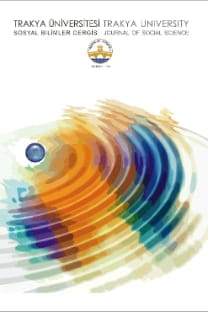S&P 500 ENDEKSİNDE TAKVİM ANOMALİSİ: MARK TWAIN (EKİM) ETKİSİ ÜZERİNE BİR İNCELEME
Takvimsel Anomaliler, Etkin Piyasalar Hipotezi, Mark Twain Etkisi, Ekim Etkisi, S&P 500 Endeksi
THE CALENDAR ANOMALY IN THE S&P 500 INDEX: A STUDY ON THE MARK TWAIN (OCTOBER) EFFECT
Market Efficiency Calendar Anomalies, Efficient Markets Hypothesis, Mark Twain Effect, October Effect, S&P 500 Index,
___
- Agrawal, A. ve Tandon, K. (1994). Anomalies or illusions? Evidence from stock markets in eighteen countries. Journal of International Money and Finance, 13(1), 83-106.
- Akbalık, M. ve Özkan, N. (2016). Haftanın günü etki̇si̇ : Bist 30 endeksi̇ payları üzerine bi̇r araştırma. Finansal Araştırmalar Ve Çalışmalar Dergisi, 8(14), 1.
- Ariel, R. (1987). A monthly effect on stock returns, Journal of Financial Economics, 18, 161-174.
- Balaban, E. (1995). January effect, yes! What about mark twain effect. TheCentral Bank of The Republic of Turkey Research, Discussion Paper No: 9509.
- Bouman, S. ve Jacobsen, B. (2002). The halloween indicator, "sell in May and go away": Another Puzzle. The American Economic Review, 92(5), 1618-1635.
- Cadsby, C.B. (1988), The CAPM and the calendar: A systematic treatment of empirical anomalies, University of Guelph, Discussion Paper 1988–9.
- Cadsby, C.B. (1988). Canadian calendar anomalies and the capital asset pricing model, University of Guelph, Working Papers 1988-12.
- Cadsby, C.B. ve F. Tapon, (1987). Risk and return on the Toronto Stock Exchange: January versus the rest of the year, University of Guelph, Discussion Paper 1987–1.
- Çinko, M. (2008). İstanbul Menkul Kıymetler Borsasında Ocak ayı etkisi. Doğuş Üniversitesi Dergisi, 9(1), 47-54.
- Davidsson, M. (2006). Stock market anomalies : a literature review and estimation of calendar affects on the S&P 500 index (Yüksek Lisans Tezi). Jönköping International Business School, Jönköping.
- Dimson, E. ve Marsh, P. (1999). Murphy's law and market anomalies. The Journal of Portfolio Management, 25(2), 53-69.
- Dzhabarov, C. ve Ziemba, W. (2010). Do seasonal anomalies still work?. Journal of Portfolio Management, 36(3), 93-104.
- Fama, E. (1965). The behaviour of stock market prices, Journal of Business, 38(1), 34-105.
- Fama, E. (1997). Market efficiency, long-term returns and behavioral finance, Journal of Financial Economics, 49, 283-306.
- Freund, J. ve G. A. Simon, (1997) Modern Elementary Statistics, Prentice-Hall International Inc, 9. Edition, 571.
- Gu, A. Y. (2003). The declining January effect: evidences from the US equity markets. The Quarterly Review of Economics, 43(2), 395- 404.
- Guimaraes, R.M.C. Kingsman, B. G. ve Taylor, S.J. (1989). A reappraisal of the efficiency of financial markets. Berlin: Springer-Verlag.
- Gultekin, M.N. ve N.B.Gultekin, (1983), Stock market seasonality: international evidence, Journal of Financial Economics, 12, 469–81.
- Jacobsen, B. ve Visaltanachoti, N. (2006). The Halloween effect in US sectors. Financial Review, 44, 437-459.
- Jones, C. ve Lundstrum, L. (2009). Is sell in May and go away a valid strategy for U.S. equity allocation? Journal of Wealth Management, 12(3), 104-112
- Kasuya, E. (2001). Mann Whitney U test when variances are unequal. Animal Behavior, 61(6), 1247-1249.
- Lakonishok, J. ve Smidt, S. (1988). Are seasonal anomalies real? A ninety-year perspective. The review of Financial Studies, 1(4), 403-425.
- Mann, H. B. ve Whitney, D. R. (1947). On a test of whether one of two random variables is stochastically larger than the other. Annals of Mathematical Statistics, 18, 50-60.
- Marquering, W., Nisser, J., ve Valla, T. (2006). Disappearing anomalies: A dynamic analysis of the persistence of anomalies. Applied Financial Economics, 16 (4), 291– 302.
- Mehdian, S. ve M.J. Perry (2002). Anomalies in US equity markets: A re-examination of the January effect. Applied Financial Economics, 12, 141-145.
- Nachar, N. (2008). The Mann-Whitney U: A test for assessing whether two independent samples come from the same distribution. Tutorials in Quantitative Methods for Psychology, 4(1), 13-20.
- Oran, J. (2019). Açıklamalı Davranışçı Finans Sözlüğü İngilizce-Türkçe, Türkçe – İngilizce. İstanbul: Çağlayan Yayınevi.
- Özkan, N. ve Akbalık, M. (2018). Hicri takvim etkisi: Borsa İstanbul gıda-içecek, hizmetleri ve ulaştırma endekslerinde yer alan paylar üzerine bir araştırma. Journal of Yaşar University, 13(49), 9-21.
- Patel, N. ve Sewell, M. (2015). Calendar anomalies: a survey of the literature. International Journal of Behavioural Accounting and Finance, 5(2), 99-121.
- Plastun, O., Sibande, X., Gupta, R., ve Wohar, M. E. (2019). Historical evolution of monthly anomalies in international stock markets. SSRN Electronic Journal, 1-42.
- Plastun, O., Sibande, X., Gupta, R., ve Wohar, M. E. (2019). Rise and fall of calendar anomalies over a century. SSRN Electronic Journal, 1-44.
- Santa, C. ve Valkanov, R. (2003). The presidential puzzle: political cycles and the stock market, Journal of Finance, 58, 1841-1872.
- Szakmary, A. C. ve Kiefer, D. B. (2004). The disappearing January/turn of the year effect: evidence from stock index futures and cash markets. Journal of Futures Markets, 24, 755-784.
- Thaler, R.H. (1987). Seasonal movements in security prices II: weekend, holiday, turn of the month, and intraday effects, Journal of Economic Perspectives Fall, 1, 169–177.
- Thaler, R.H. (1987). The January effect, Journal of Economic Perspectives Summer, 1, 197–201.
- Twain, M. (1998). Pudd'nhead Wilson; Those extraordinary twins; The man that corrupted Hadleyburg. New York: Oxford University Press.
- Wachtel, S.B. (1942). Certain observations on seasonal movements in stock prices, The Journal of Business, University of Chicago Press, 15, 184-193.
- ISSN: 1305-7766
- Yayın Aralığı: 2
- Başlangıç: 2000
- Yayıncı: Trakya Üniversitesi Sosyal Bilimler Enstitüsü
TÜRKİYE - ABD KARŞILIKLI BAĞIMLILIK İLİŞKİLERİNİN SEKTÖREL ANALİZİ
ANADOLU HALK EZGİLERİNDE KARAR VE PERDE DERECELERİNİN ÖNEMİNDEN HAREKETLE SINIFLANDIRILMASI
GAYRİMENKUL YATIRIM FONLARI ve GELİŞİMLERİNE YÖNELİK ÖNERİLER
Esma UZUNHİSARCIKLI, E KAVUNCUOGLU, Hanife AKGÜL
EASTERLIN PARADOKSUNUN ALTERNATİF BİR YAKLAŞIMLA İNCELENMESİ: PANEL KESİRLİ POLİNOMİYAL MODELLER
Serkan KANDIR, Gözde ELBİR MERMER
